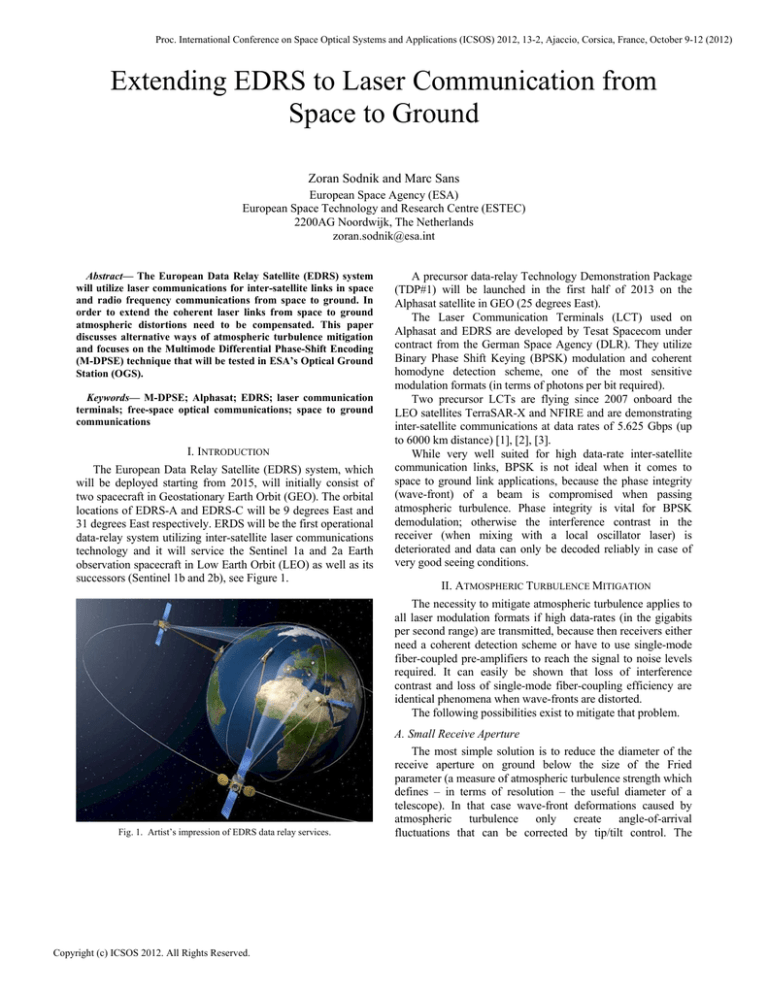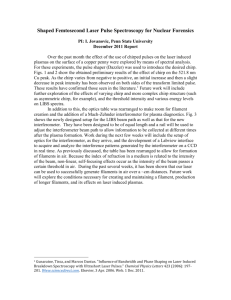
Proc. International Conference on Space Optical Systems and Applications (ICSOS) 2012, 13-2, Ajaccio, Corsica, France, October 9-12 (2012)
Extending EDRS to Laser Communication from
Space to Ground
Zoran Sodnik and Marc Sans
European Space Agency (ESA)
European Space Technology and Research Centre (ESTEC)
2200AG Noordwijk, The Netherlands
zoran.sodnik@esa.int
Abstract— The European Data Relay Satellite (EDRS) system
will utilize laser communications for inter-satellite links in space
and radio frequency communications from space to ground. In
order to extend the coherent laser links from space to ground
atmospheric distortions need to be compensated. This paper
discusses alternative ways of atmospheric turbulence mitigation
and focuses on the Multimode Differential Phase-Shift Encoding
(M-DPSE) technique that will be tested in ESA’s Optical Ground
Station (OGS).
Keywords— M-DPSE; Alphasat; EDRS; laser communication
terminals; free-space optical communications; space to ground
communications
I. INTRODUCTION
The European Data Relay Satellite (EDRS) system, which
will be deployed starting from 2015, will initially consist of
two spacecraft in Geostationary Earth Orbit (GEO). The orbital
locations of EDRS-A and EDRS-C will be 9 degrees East and
31 degrees East respectively. ERDS will be the first operational
data-relay system utilizing inter-satellite laser communications
technology and it will service the Sentinel 1a and 2a Earth
observation spacecraft in Low Earth Orbit (LEO) as well as its
successors (Sentinel 1b and 2b), see Figure 1.
A precursor data-relay Technology Demonstration Package
(TDP#1) will be launched in the first half of 2013 on the
Alphasat satellite in GEO (25 degrees East).
The Laser Communication Terminals (LCT) used on
Alphasat and EDRS are developed by Tesat Spacecom under
contract from the German Space Agency (DLR). They utilize
Binary Phase Shift Keying (BPSK) modulation and coherent
homodyne detection scheme, one of the most sensitive
modulation formats (in terms of photons per bit required).
Two precursor LCTs are flying since 2007 onboard the
LEO satellites TerraSAR-X and NFIRE and are demonstrating
inter-satellite communications at data rates of 5.625 Gbps (up
to 6000 km distance) [1], [2], [3].
While very well suited for high data-rate inter-satellite
communication links, BPSK is not ideal when it comes to
space to ground link applications, because the phase integrity
(wave-front) of a beam is compromised when passing
atmospheric turbulence. Phase integrity is vital for BPSK
demodulation; otherwise the interference contrast in the
receiver (when mixing with a local oscillator laser) is
deteriorated and data can only be decoded reliably in case of
very good seeing conditions.
II. ATMOSPHERIC TURBULENCE MITIGATION
The necessity to mitigate atmospheric turbulence applies to
all laser modulation formats if high data-rates (in the gigabits
per second range) are transmitted, because then receivers either
need a coherent detection scheme or have to use single-mode
fiber-coupled pre-amplifiers to reach the signal to noise levels
required. It can easily be shown that loss of interference
contrast and loss of single-mode fiber-coupling efficiency are
identical phenomena when wave-fronts are distorted.
The following possibilities exist to mitigate that problem.
Fig. 1. Artist’s impression of EDRS data relay services.
Copyright (c) ICSOS 2012. All Rights Reserved.
A. Small Receive Aperture
The most simple solution is to reduce the diameter of the
receive aperture on ground below the size of the Fried
parameter (a measure of atmospheric turbulence strength which
defines – in terms of resolution – the useful diameter of a
telescope). In that case wave-front deformations caused by
atmospheric turbulence only create angle-of-arrival
fluctuations that can be corrected by tip/tilt control. The
Proc. International Conference on Space Optical Systems and Applications (ICSOS) 2012, 13-2, Ajaccio, Corsica, France, October 9-12 (2012)
problem using small apertures (smaller or equal to the smallest
Fried parameter at which the system needs to be operational) is
a low receive power and – much more important – strong
scintillations (intensity fluctuations) caused by beam wander
and interference. As the scintillations are not compensated by
aperture averaging (a small aperture does not average well)
their dynamic range generally exceeds the capabilities of
coherent receivers. Space to ground communication links using
BPSK and small apertures are therefore only attempted at
excellent astronomical locations (e.g. mountain tops), where
atmospheric turbulence is more benign. Successful space to
ground communication links have been performed with a
coherent receiver with 60 mm aperture diameter from ESA’s
Optical Ground Station (OGS) in Izaña, Tenerife [4].
B. Adaptive Optics
Adaptive optics (AO) was originally proposed in the 1950s,
but the technology only became mature in the 1970s, when it
was secretly developed for military imaging applications [5].
Widespread use in astronomy started in the beginning of the
1990s, when adaptive optics technology became affordable and
computers fast enough. Astronomers using large aperture
telescopes have always been frustrated by the fact that their
image resolution does not exceed the one obtained by small
star gazing amateur telescopes (due to the Fried parameter).
This changed with adaptive optics, where the wave-front
(phase) deformations of the received light are measured and
corrected by applying the inverse deformation (e.g. by a
deformable mirror).
The number of wave-front corrections required is
approximately given by square of the ratio between telescope
diameter and the Fried parameter, which can become a large
number for large astronomical telescopes. A couple of
simplifications to the AO system are possible, because the light
in optical communications:
is monochromatic and no chromatic dispersion occurs
in the atmosphere;
is circularly polarized and polarization beam routing
schemes can simplify the set-up;
originates from a point source, which the AO
correction algorithm has to convert back into a point
source.
Taking these design simplifications into account the
schematic drawing of the adaptive optics system for EDRS
ground stations is shown in Figure 2.
The AO system was tested in ESA’s Optical Ground
Station (OGS) in Tenerife, Spain, and an improved version will
be implemented in the Transportable - Adaptive Optics Ground
Station (T-AOGS), which is under developed by the German
Space Agency (DLR). The AO system in Figure 2 does not
show compensation of angle-of-arrival fluctuations of the
incoming beam (performed by a fast tip/tilt mirror before the
AO) and assumes that an image of the telescope entrance pupil
is located on the surface of a deformable mirror (DM). The
circularly polarized laser beam from the satellite passes a
quarter wave plate (QWP1) that converts it into linear
polarized light, so that all light passes a polarization beam
splitter (PBS1). PBS1 is followed by QWP2, which rotates the
polarization by 90 degrees upon reflection on the DM. The
beam is subsequently reflected by PBS1 and routed towards a
pupil reimaging a-focal system composed of two aspheric
lenses (L1 and L2).
The focal ratio between the two lenses is used to adapt the
pupil size to the requirements of a Shack-Hartmann (SH)
sensor, formed by a Lens(let) array and a Camera. QWP3 in
front of PBS2 allows adjustment of the optimum intensity
distribution between SH sensor and the Output beam [6].
C. Multimode – Differential Phase-Shift Encoding (M-DPSE)
A relatively simple alternative to the use of adaptive optics
is Multimode-Differential Phase Shift Encoding (M-DPSE).
Its detection principle is identical to Differential Phase Shift
Keying (DPSK) used in terrestrial fiber-based telecommunication networks and also proposed for free-space
Fig. 2. Schematic drawing of the adaptive optics system, which will be implemented in the OGS.
Copyright (c) ICSOS 2012. All Rights Reserved.
Proc. International Conference on Space Optical Systems and Applications (ICSOS) 2012, 13-2, Ajaccio, Corsica, France, October 9-12 (2012)
communications by NASA for its Laser Communication Relay
Demonstration (LCRD). It is based on interference of
successive data bits in an unequal arm-length interferometer,
where the optical path difference (OPD) in the interferometer
corresponds to the duration of one bit. The coherence length of
the laser light needs to be much longer than the OPD, which
needs to be stabilized in the interferometer to a fraction of the
wavelength. The relative phases of two successive data bits are
converted into intensity by interference. If the phases of two
successive bits are identical the result is constructive
interference, while if two successive bits of are different the
output will be destructive interference. However, as the
encoding of the data is Binary Phase Shift Keying (BPSK) and
not DPSK, the received bit sequence becomes the derivative of
the bit sequence sent.
While DPSK is used in single mode operation only MDPSE operates equally well in multi-mode conditions if the
two interfering bits experience identical wave-front distortions.
One way to achieve that is pupil imaging [7].
Fig. 3. Schematic drawing of the M-DPSE system based on a Michelson
interferometer.
A schematic drawing of a multi-mode Michelson type
interferometer with unequal arm-length is shown in Figure 3.
Each interferometer arm uses a single achromatic lens to reimage the pupil. The focal lengths of the lenses together with
the thickness of the beam-splitter plate are selected to achieve
the required OPD and to maintain identical location of the
output pupil. In principle the location of input pupil and output
pupil can be placed anywhere, as long as they are identical in
position and size for both interferometer arms. Mirror M2 is
controlled by a Piezo-crystal to maintain the operational bias
point in the interferometer to a fraction of the wavelength
despite Doppler shift of the light received [8]. Both mirrors are
covered by a thin glass plate in order to prevent dust particles
from disabling the interferometer (at the beam focus).
The modulation contrast in an interferometer depends on
interference of identical wave-fronts, not on the quality of the
wave-front itself. To maintain identical wave-fronts, the
Copyright (c) ICSOS 2012. All Rights Reserved.
entrance pupil is imaged in both arms onto the same exit pupil.
This ensures that the interferometer superimposes identical
wave-fronts (within the bit duration the wave-front cannot
change because atmospheric turbulence effects are much
slower) and optimum modulation contrast is obtained despite a
distorted input wave-front.
While the M-DPSE solves the interference contrast
problem, it does not remove atmospheric wave-front
distortions and focusing into the tiny mode field area of a
single-mode fiber is still not possible. However, the sensitive
area of high speed (≤10 Gbps) photo-detectors is much larger
and the net gain of the M-DPSE technique is therefore given by
the area ratio between photo-detector and diffraction limited
point spread (Airy-) function. While the diameter of the photodetector (onto which the light from the interferometer is
focused) is 60 µm, the mode field diameter of a single mode
fiber (NA=0.15) at that 1064 nm wavelength would be around
10 µm.
Fig. 4. Michelson interferometer with pupil-imaging lenses in both arms. The
entrance aperture is in the lower left and the exit aperture is in the lower
right. The beam splitting plate, the pupil imaging lenses and the end
mirrors (one with piezo-control) are visible.
Figure 4 shows a M-DPSE Michelson-type interferometer
developed for the reception of Binary Phase Shift Keying
(BPSK) modulated data from laser communication terminals
on-board the TerraSAR-X and NFIRE satellites. The
wavelength used is 1064 nm and the data rate is 5.625 Gbps.
This system has been successfully tested with turbulence
generators to verify the M-DPSE principle.
III. IMPLEMENTATION OF M-DPSE IN ESA’S OGS
The M-DPSE interferometer which will be installed at
ESA’s Optical Ground Station will provide the ERDS project
with a relatively simple commissioning and testing facility for
their laser communication terminals on-board the Alphasat,
ERDS-A and EDRS-C satellites. The OGS has already
performed similar tasks with LCTs on-board the ARTEMIS,
OICETS, TerraSAR-X and NFIRE satellites [9], [10], [11].
Being a ground based facility, the OGS can also measure
Proc. International Conference on Space Optical Systems and Applications (ICSOS) 2012, 13-2, Ajaccio, Corsica, France, October 9-12 (2012)
received beam parameters, such as central wavelength,
wavelength stability and polarization as well as the acquisition
and communication timing [12]. The 1 meter Zeiss telescope of
the OGS is shown in Figure 5.
The M-DPSK interferometer, which will be built for
decoding laser communication data from Alphasat and EDRS,
is shown in Figure 6. It utilizes a beam-splitter cube (BSC), a
glass block mirror (GBM) in one arm and a piezo-crystal
controlled standard mirror (M1) in the other.
Fig. 5. 1 meter Zeiss telescope of the OGS
The physical location and the communication parameters of
the OGS are summarized in Table 1.
TABLE I.
OPTICAL GROUND STATION SPECIFICATIONS
Parameter
Value
Unit
Geographic longitude
16° 30’ 36.36”
West
Geographic latitude
28° 17’ 58.29”
North
Altitude above sea level
2393
m
Receiver telescope diameter
1016
mm
Receiver focal length
39000
mm
Transmitter diameter
39
mm
Transmitter laser power
50
W
Communication wavelength
Communication data rate
1064
nm
2.8125
Gbps
A. Further M-DPSK Simplification
The Michelson type M-DPSK interferometer presented in
Figures 3 and 4 can be further simplified because pupil
imaging is actually not required. This was proposed by Kylia,
the French company that built the M-DPSK interferometer
under ESA contract.
Refractive properties of a glass substrate in one arm of the
interferometer can be utilized to perform two functions,
namely:
to provide the required OPD between interferometer
arms;
to maintaining identical etendue in both interferometer
arms;
Copyright (c) ICSOS 2012. All Rights Reserved.
Fig. 6. M-DPSK interferometer design.
To satisfy the OPD as well as the etendue requirements, the
following interferometer component dimensions have to be
fulfilled:
2 y 2n e 2 x OPD
2e
2 y 2x 0
n
With (y) the distance between the beam splitter cube and
the glass block mirror, (e) the length of the glass block mirror
of refractive index (n) and (x) the distance between the beam
splitter cube and mirror M1. Combining equations 1 and 2 one
gets the following interferometer dimensions:
OPD
2(n 2 1)
e n ( x y)
x y
For N-BK7 (with an index of refraction of n = 1.5067 at
1064 nm) the differential component separation in the
interferometer arms becomes x-y = 41.962 mm and the
thickness of the glass block mirror e = 63.224 mm. For
ultimate compactness the y dimension can be reduced to zero
making one interferometer arm monolithic.
It can easily be shown that dimensional requirements are
both violated with the cosine of the field angle where the error
becomes 1% at a field angle of 8 degrees. Assuming a 1 meter
aperture, as shown in Figure 5, and a telescope magnification
Proc. International Conference on Space Optical Systems and Applications (ICSOS) 2012, 13-2, Ajaccio, Corsica, France, October 9-12 (2012)
of 100, a 1% error is reached when the external telescope field
angle becomes ±4.8 arcmin. However this only applies to
higher order wave-front errors as tip/tilt is removed via a
control loop.
In simple terms the “lens-less” M-DPSK interferometer
design maintains identical beam properties (etendue) at the
interferometer output despite the optical path difference (OPD)
of the interferometer arms. The lack of pupil imaging requires
a somewhat larger aperture lens system that focuses the light
onto a detector caused by higher order wave-front distortions
that are not compensated by tip/tilt.
B. Receiver design
Figure 7 shows the focal plane instrumentation with MDPSE interferometer that will be installed in the Coudé beam
path of ESA’s Optical Ground Station (OGS) telescope.
By motorized rotation of the QWP the splitting ratio of a
polarizing beam splitter (PBS) is adjusted for optimum power
distribution between Camera and M-DPSE interferometer. The
focal plane instrumentation is shown in Figure 8.
The interferometer output is focused onto an (10 Gbps)
avalanche photo-Detector (Discovery Semiconductors), where
the derivative of the originally transmitted BPSK bit sequence
is recorded. The bit sequence derivative is caused by the
differential detection principle of the M-DPSE interferometer,
if BPSK modulation is applied as input. The signal is amplified
and passes data and clock recovery electronics before bitwise
integration is performed to retrieve the original bit sequence.
Figure 9 shows a principle sketch of the electronics circuit
design for bit sequence integration. It has been developed using
evaluation boards of high frequency dual D-type flip/flop and
an XOR gates (Hittite Corp.).
Fig. 9. Synchronous high speed bit integration circuit
Fig. 7. Focal plane instrumentation with M-DPSE.
The light from the telescope’s primary focus is collimated
and tip/tilt correction is performed at the internal pupil using a
fine steering mirror (FSM). After reflection by the FSM, the
circularly polarized beam passes a quarter wave plate (QWP)
which converts it into linearly polarized light.
Fig. 8. Mechanical design of the focal plane instrumentation
Copyright (c) ICSOS 2012. All Rights Reserved.
C. Transmitter design
The transmitter is completely separated from the receiver
in order to minimize stray-light from the fiber amplifier (50
Watts) to enter the receive telescope. A 1064 nm seed laser,
based on a Nd:YAG non-planar ring oscillator (Mephisto) is
fiber coupled to a phase modulator (Northrop Grumman
Corp.). The phase modulator output is routed via a long
polarization maintaining single-mode fiber to the side of the
telescope tube, where the fiber amplifier (Nufern) and the laser
transmitter system are also attached, as shown in Figure 10.
Fig. 10. Transmitter system as installed at the OGS telescope for TerraSARX and NFIRE satellite communication experiments
Proc. International Conference on Space Optical Systems and Applications (ICSOS) 2012, 13-2, Ajaccio, Corsica, France, October 9-12 (2012)
D. Transmitter/receiver alignment
In order to align the optical axes of transmitter and receiver
a high precision (<1 arcsecond) corner-cube retro-reflector
(CCRR) bar as shown in Figure 11 will be placed in front of
the 39 mm diameter transmit beam such that the retro-reflected
beam is laterally shifted and enters the telescope aperture. A
retro-reflector bar can be seen as a cut-out of a large CCRR. It
is used for lateral displacement of the retro-reflected beam,
while maintaining perfect parallelism. Diffraction will enlarge
the point spread function (PSF) on the camera from each
transmit beam by a factor of 30 beyond the PSF diameter from
a satellite, which needs to be taken into account during
alignment. However, the diameter represents the true far field
divergence of the transmit beam.
Fig. 11. Corner-cube retro-reflector bar made from Zerodur for thermal and
mechanical stability with 50 cm length and 50 mm aperture.
IV. CONCLUSIONS
This novel detection concept may well become the enabling
technology for using coherent modulation techniques through
atmospheric turbulence. It may pave the way for the
implementation of inexpensive ground-based optical telescope
receivers for cloud coverage mitigation by meteorological
space diversity. The detection principle can also be used with
non-diffraction limited telescopes and large apertures.
Copyright (c) ICSOS 2012. All Rights Reserved.
ACKNOWLEDGMENT
The authors would like to thank the company Kylia (Paris)
for the development of the first prototype of the M-DPSE
interferometer and acknowledge the most valuable
contributions from Aurélien Boutin. We would also like to
thank Jyri Kuusela and David Abreu from Ataman Science for
the development and testing of a Novel Optical Receiver
Assembly (NORA) based upon the M-DPSK interferometer
and Bernhard Wandernoth from Synopta for his consultancy in
high-speed detection technology.
REFERENCES
[1] R. Lange, B. Smutny, "Homodyne BPSK-based optical intersatellite communication links", Proc. SPIE 6457, (2007).
[2] B. Smutny et al, "In-orbit verification of optical inter-satellite
communication links based on homodyne BPSK", Proc. SPIE
vol. 6877, (2008).
[3] B. Smutny et al, "5.6 Gbps optical inter-satellite communication
link", Proc. SPIE vol. 7199, (2009).
[4] R. Fields, D. Kozlowski, H. Yura, R. Wong, J. Wicker, C.
Lunde et al., “5.625 Gbps Bidirectional Laser Communications
Measurements Between the NFIRE Satellite and an Optical
Ground Station” IEEE Proc. pp. 44–53, (2011).
[5] N. Devaney et al., "Correction of ocular and atmospheric
wavefronts: a comparison of the performance of various
deformable mirrors", Appl. Opt. 47, 6550-6562 (2008).
[6] Th. Berkefeld, D. Soltau, R. Czichy, E. Fischer, B. Wandernoth
and Z. Sodnik, “Adaptive optics for satellite-to-ground laser
communication at the 1m Telescope of the ESA Optical Ground
Station, Tenerife, Spain”, Proc. SPIE vol. 7736, (2010).
[7] Z. Sodnik, J. Perdigues, R. Czichy, and R. Meyer, "Adaptive
Optics and ESA's Optical Ground Station", Proc. SPIE vol.
7464, (2009).
[8] T. Rose, C. Klimcak, D. Kozlowski, G. Sefler, H. Yura, A.
Walston, N. Werner and C. Mueller, “Wavelength Tracking
Interferometer for DPSK” IEEE Proc. pp. 308–313, (2011).
[9] J. Romba, Z. Sodnik, M. Reyes, A. Alonso and A. Bird, “ESA’s
Bidirectional
Space-to-Ground
Laser
Communication
Experiments”, Proc. SPIE vol. 5550, (2004).
[10] A. Alonso, M. Reyes and Z. Sodnik, “Performance of satelliteto-ground communications link between ARTEMIS and the
Optical Ground Station”, Proc. SPIE vol. 5572, (2004).
[11] Z. Sodnik, H. Lutz, B. Furch and R. Meyer, “Optical Satellite
Communications in Europe”, Proc. SPIE vol. 7587, (2010).
[12] R. Czichy, Z. Sodnik and B. Furch, “Design of an Optical
Ground Station for In-Orbit Check-Out of Free Space Laser
Communication Payloads”, Proc. SPIE vol. 2181, (1995).





